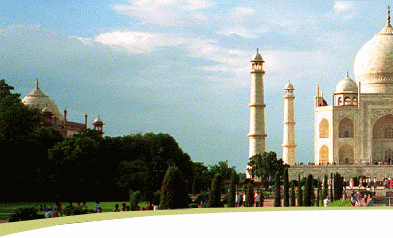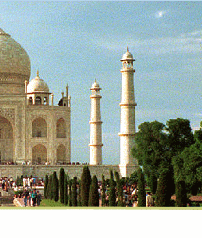|
||||||||||



| Sikkim Information | |||||||||||||||||
|
|||||||||||||||||
|
|||||||||||||||||
| Land The area of the Indian federal state of Sikkim encompasses solely the upper valley and the source of the Teesta River - a tributary of the Brahmaputra. Roughly square in shape, the country is bound to the north, east and west by three watershed ridges; the eastern and northern border is with Tibet whilst the western border with Nepal runs along the Singalila Ridge, a spur of Kanchenjunga. The southern border with West Bengal is formed by the mountain rivers Rangit and Rangpo, both of them tributaries of the Teesta. Nowadays Sikkim proper begins at the foot of the mountains, but in former times encompassed Darjeeling and Kalimpong. Sikkim's landscape is dominated by the 8,597 metre high (28,370-ft.high) massif of Kanchenjunga and its 31 kilometre long (18.6 miles) Zemu glacier on the western border. The long Teesta valley, traversing the whole country from north to south, allows the summer monsoon rain to push far to the north at its highest level of intensity. As a result of these large amounts of rainwater many narrow valleys were deeply cut into the rather soft stone (Daling slate) in the south. Level surfaces can be found only in the most extreme north (High Sikkim), where the dryness has created a treeless alpine steppe. Its barren high surfaces and mountains covered with rubble and boulder formations mark the transition to the highlands of Tibet. Due to the heavy precipitation, the mountainous landscapes of upper and lower Sikkim are heavily forested. In the lower levels can be found the wet sal forest - a hardwood related to teak and host to more than 600 species of orchids. As you ascend you pass through a great variety of forest landscapes - tropical evergreen mountain and rain forests, characterised by tree ferns and epiphytes. Higher still there is bamboo, oak, beech, chestnut, giant magnolia, rhododendron trees and, highest of all, various species of conifers. The tree line itself varies from 3,600 to 4,200 metres (12,000 to 14,000ft) above sea level. In Sikkim tropical plants of different climatic regions mix together as nowhere else in the Himalaya. A corresponding variety exists in the animal world, with over 500 species of birds in this small area alone. Antelope, wild sheep and goats as well as wild asses and yaks can be found in the north. In the forested valleys live bears, lesser (red) pandas, silver foxes and leopards, and in the south rhesus macaques, langurs and other monkey species. History In the 18th century armies from Bhutan and the Gurkha empire in Nepal invaded. Sikkim lost considerable amounts of territory to its neighbouring kingdoms. When the Gurkhas were defeated by the Chinese army in a campaign against Tibet in 1791-92, Sikkim won back its northern sections, but the Chumbi valley was to remain in Tibet. After the British victory over Nepal in 1817, the southern part of the country was given back to Sikkim. However, during the next conflict with Nepal in 1827, Darjeeling had to be relinquished to the British to gain their support. In 1848 the entire Terai Lowlands and the mountain periphery was annexed by British India. Within a single century Sikkim was reduced to a fraction of its former territory. Since the beginning of the 19th century, Nepalese have increasingly emigrated to Sikkim, eventually surpassing the number of natives. This led to internal tension. After the British had refused to help stop the influx of Nepalese, the Gyalpos supported a Tibetan military plan during which Tibet seized a stretch of land near Darjeeling with a small unit of troops. In ensuing battles the British retained the upper hand and Sikkim became a British protectorate in 1890. The British had won their long sought-after gateway to Tibet. The state was controlled for years by the British political officer Claude White, who in effect stripped the Gyalpos of their power. Not until the reign of Sidkeong Tulku and Tashi Namgyal was the king's power restored. The Indian Union took over the protectorate in 1950
and intervened between representatives of different Sikkim ethnic
groups in 1973 after long lasting political conflicts. The Gyalpos
lost their power as a result of the new democratic constitution.
Consequently the pro-Indian Nepali population became more influential.
A law introduced into the parliament made Sikkim, by annexation
an associated Indian partial state. It became the 22nd federal state
of the Indian Union in 1975 through an amendment to the constitution. People Cities GANGTOK Altitude: 1550m Once the Sikkimese capital, now the state capital, Sikkim sits astride a steep sided ridge in a similar setting to Kalimpong. The town itself is a little run down, built helter skelter across the hill sides. The Chogyal’s palace on top of the ridge is still inhabited by his politically powerless descendants, although they are still held in deep respect by conservative Sikkimese. The town is small, with most facilities in the space of a couple of streets. Along the top of the ridge there are plenty of vantage points across the surrounding hills, and there are numerous parks and gardens to rest in. Places to visit include the Government Institute of Cottage Industries, a craft centre, Enchey Monastery just outside the town, the various Orchidaria and Gardens, and the bustling town market. The Chogyal’s Palace is closed to the public. At the southern end of the town is the Research Institute of Tibetology, a study centre, with the Do Drul chorten above it. |
|||||||||||||||||
 |

